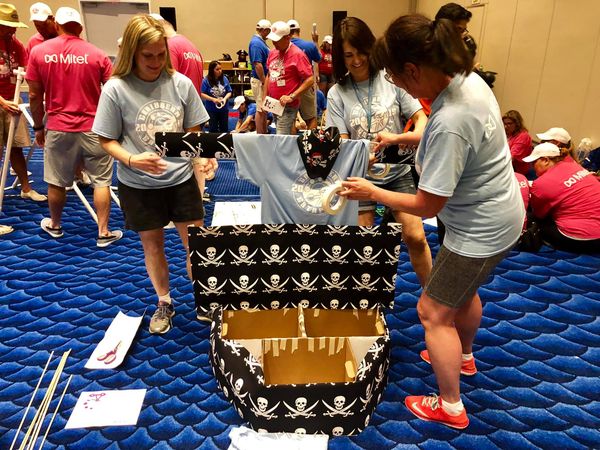A good company culture is a key aspect of organizational success, and it can help your business become more innovative, profitable, and driven. However, maintaining that culture can be a challenge. There are numerous company culture killers that can hinder progress, decrease engagement, lower productivity, and more.
In our latest episode of the Team Building Saves the World podcast, we sat down with Kim Crowder—communication consultant and the CEO of Kim Crowder Consulting—for a conversation about the importance of a people first leadership, corporate culture killers, and how to create a people first culture.
During our conversation, Crowder emphasized the importance of being an inclusive, people first company, saying, “what we do is help leadership teams frame that [inclusion] and also create that in a way that is human centered, so that they are supporting their team members across the board and creating an environment that says no to others who would oppose that.”
In this blog, we’ll take a look at company culture killers, how to avoid them, creating a people first culture, and the common challenges that come with that.
Understanding Company Culture Killers
First, let’s focus on understanding company culture killers. Company culture killers are behaviors, attitudes, and habits that actively and passively have a negative impact on your corporate culture. There are numerous different culture killers, and it’s important to be aware of them.
Culture killers can have a bigger impact than you might think. They can decrease motivation, morale, engagement, retention, and innovation, and much more. If your company culture isn’t healthy, your employees won’t be able to do their best. And as a result, your company won’t do its best either.
Culture killers can be complex or very simple. For example, something as simple as the layout of your workplace can be a culture killer. Rearranging your office might be all you need to do to start improving your company culture.
Conversely, it could also be something much more complex. Something like a fear of tough conversations can have a huge negative impact on your company culture, but that can be a little harder to address. Typically, fear comes from behaviors and attitudes that have been present for a while. Getting people to change their habits and mentality can be a big undertaking.
Crowder noted two common culture killers during our conversation—misunderstanding data and not listening to employees. She told a story about a company that was having difficulty with their culture, and those two issues were a big hurdle.
“That’s the challenge of workplace data. If you’re presenting that data in a way that hasn’t been really critical of the data, then we may miss the story,” Crowder said. “And so… not understanding data is a major workplace killer. Your team members may have already been telling you what’s going on in the workplace, but you just haven’t been listening, right?”
There are countless other culture killers, and it’s nearly impossible to be aware of every single one. That’s why identifying them and recognizing the signs is essential if you want to start putting people first and create a positive workplace culture.
Recognizing the Signs
Let’s briefly focus on recognizing the signs of a toxic work environment. Toxic work environments and culture killers go hand in hand, so learning to recognize one will help you identify the other as well.
The simplest and most obvious sign of a toxic workplace is that people aren’t happy and aren’t enjoying their time at work. If employees are burnt out, have low morale, and complain about work-life balance, it’s a strong sign that your work environment is toxic.
Communication issues are one of the most common signs of issues in the workplace, and it’s often missed. If employees feel like they can’t speak up, don’t have their input valued, and are afraid to raise concerns, there’s likely an issue with your workplace culture.
Another common sign is not putting people first. For example, deadlines are a great way to see if a company values its employees. If a deadline is set and employees are voicing concerns about their mental health in relation to meeting it, a company should consider their input and reevaluate the deadline. But if a company ignores those concerns and presses on anyways, that’s a sign they aren’t putting people first.
What is a People First Culture?
So, what even is a people first culture? As the name suggests, it is a culture in which people are prioritized. A people first culture seeks to put employees first, help them feel supported, connected, and cared about.
Going deeper, a people first culture fosters collaboration and teamwork, and it prioritizes employee well-being. A people first company makes sure that employees aren’t burnt out, gives them the breaks and PTO they need, ensures a healthy work-life balance, and works to see that employees have good mental health.
A people first culture is also built around trust and open communication. It’s impossible to create a positive work environment without being open, allowing for criticism, and letting employees have their voices heard without fear of repercussions.
The benefits of a people first culture are plentiful. When employees get the support and care they need, they are going to be better workers. They will be more engaged, more motivated, more willing to collaborate, etc. You want workers who are happy and excited to work, and that is the case in people first companies. That’s why it’s so important to have a psychologically safe workplace that puts people first.
Leadership’s Role in Creating a People First Culture
Unsurprisingly, leadership plays an important role in creating a people first culture. If leadership doesn’t want to make a change, it simply will not happen. Crowder illustrated this point in our conversation with a story about a company she was hired to help.
“We found that one company was losing, because of a lack of retention, $9 million a year because employees were leaving. When we looked at that data, what we found is 101% of their black employees were cycling out every year.” Crowder continued, saying, “We felt really strongly about this, but when we turned the data around to the C-suite, they weren’t as invested.”
Even when presented with stats showing they were losing a large sum of money due to their poor culture, the executives didn’t want to change. If you want to create a people first culture, it has to start from the top.
So what can leaders and management do to create a people first culture? First off, they need to lead by example. Whatever changes you want to make, you have to start by doing them yourself. If you want employees to communicate more freely, make yourself open to them so they can voice their opinions and concerns.
They should also go out of their way to encourage employees to make changes, as well as recognize those positive behaviors. A little bit of encouragement and recognition can go a long way when it comes to making positive changes in the workplace.
Strategies for Cultivating a People First Culture
Now, let’s talk about some action strategies you can use to cultivate a people first culture. There are lots of ways to go about it, but these are some of the more common and most effective ones.
Having effective feedback and communication channels is a key people first strategy. You can’t start putting people first if they can’t communicate with you and provide feedback. Management should make themselves open to discussion, and they should take feedback seriously. You could also consider anonymous feedback, that way employees can speak without any fears.
Data can also be incredibly valuable. It can help you see things that you might not notice on the surface, such as a certain demographic having a high turnover rate, a large number of employees being burnt out, etc.
However, remember that data isn’t everything. It’s easy to misunderstand data, and oftentimes data shows something that your employees have already been saying. So be careful about how you utilize data, and remember to listen to your employees.
Lastly, team building exercises can be a great way to invest in employees and focus on a people first culture. Events like Shark Teams and Catapult to Success can be a great way to build relationships, improve communication, better teamwork, and improve your skills, all while having some fun.
Overcoming Challenges in Creating a People First Culture
Before finishing up, let’s quickly mention some of the challenges involved with creating a people first culture. Making big changes isn’t easy, so it’s important to know how to overcome some of the common challenges.
One of the biggest challenges is handling setbacks and learning from failures. It’s easy to get discouraged if things aren’t working out how you had hoped, but that doesn’t mean you should give up. Instead, you should analyze what happened and try to learn from those mistakes.
The other big challenge is sustaining changes. Lots of companies make changes for the better, but they eventually end up sipping and end up where they started. The best way to prevent this is to implement people first strategies directly into your regular procedures, rules, and policies.
Instead of making superficial changes that can easily fade over time, work them into the core of your company. Something like a rule that ensures everyone has time to speak in meetings can prevent you from losing the gains you had made.
You should also continually assess the state of your workplace. Are people gossiping? Is there burn out? Are people communicating well? Staying vigilant can help you stop from regressing before it gets out of hand, and it allows you to make smaller changes over time instead of needing a big overhaul.
Put Your Employees First and Better Your Corporate Culture
Put your employees first and better your corporate culture. An employee first culture can help you increase motivation, engagement, and productivity. Company culture killers can stand in the way, but you can overcome them by implementing people first strategies like open communication and feedback.
Start improving your culture today with Team Bonding. We have a range of events that are perfect for improving your company culture, so get in touch with us today.















